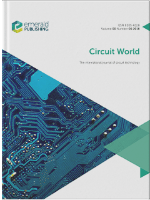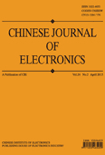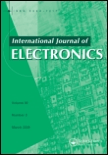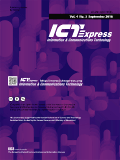
Journal of Electronics & Information Technology
Scope & Guideline
Shaping the Future of Electronic Engineering
Introduction
Aims and Scopes
- Electronics and Communication Systems:
The journal extensively covers topics related to electronic devices, communication systems, and network technologies, focusing on innovations in wireless communication, signal processing, and data transmission. - Artificial Intelligence and Machine Learning Applications:
A significant portion of research is dedicated to the application of AI and machine learning techniques in electronics and information systems, including algorithm development, predictive modeling, and intelligent system design. - Embedded Systems and IoT:
The journal emphasizes research in embedded systems and the Internet of Things (IoT), exploring topics such as sensor networks, smart devices, and integration of IoT in various applications. - Robust Security and Privacy Mechanisms:
There is a consistent focus on security mechanisms for electronic communications, including cryptographic methods, secure data transmission, and privacy-preserving technologies. - Advanced Signal Processing Techniques:
The journal features advancements in signal processing methods, including image processing, audio signal analysis, and the application of deep learning techniques in signal enhancement and classification. - Emerging Technologies in Electronics:
Research on emerging technologies, such as quantum computing, memristors, and novel materials for electronic applications, is a core area of interest. - Sustainable and Energy-Efficient Solutions:
The journal also addresses the development of sustainable technologies and energy-efficient solutions in electronics, including optimization algorithms for power consumption.
Trending and Emerging
- Integration of AI in Electronics:
The integration of artificial intelligence in various electronic applications, such as smart devices and autonomous systems, is a rapidly growing theme, highlighting the role of AI in enhancing performance and functionality. - 5G and Next-Generation Communication Technologies:
There is a marked increase in research related to 5G technologies and future communication systems, focusing on aspects such as resource allocation, network slicing, and low-latency applications. - Reconfigurable Intelligent Surfaces (RIS):
The exploration of reconfigurable intelligent surfaces for enhanced wireless communication is gaining traction, showcasing innovative solutions for improving network performance. - Federated Learning and Privacy-Preserving Techniques:
Emerging research on federated learning and privacy-preserving technologies highlights the growing concern for data security and privacy in the context of machine learning and IoT. - Energy Harvesting and Sustainable Technologies:
Research themes focusing on energy harvesting methods and sustainable technologies are on the rise, reflecting a global push towards eco-friendly solutions in electronics. - Quantum Computing and Information Processing:
The exploration of quantum computing technologies and their applications in information processing is increasingly prominent, indicating a shift towards next-generation computing paradigms. - Advanced Image Processing Techniques:
There is a notable trend in the development of advanced image processing techniques, particularly those leveraging deep learning for applications in medical imaging and surveillance.
Declining or Waning
- Traditional Circuit Design Techniques:
There has been a noticeable decrease in publications focusing on conventional circuit design methods, likely due to the shift towards more integrated and automated design approaches that utilize advanced computational techniques. - Basic Theoretical Physics in Electronics:
Research that primarily emphasizes fundamental theoretical physics related to electronics has diminished, as the field moves towards more application-oriented and interdisciplinary approaches. - Low-Level Programming and Hardware Description Languages:
As the trend moves towards higher-level abstractions and automated tools for hardware design, the focus on low-level programming and traditional hardware description languages has waned. - Analog Signal Processing Techniques:
With the rise of digital and machine learning-based signal processing methods, traditional analog signal processing techniques are being published less frequently. - Classic Networking Protocols:
Research on classical networking protocols has declined, with a shift towards exploring more advanced and adaptive networking solutions, such as those driven by AI.
Similar Journals

IEEE COMMUNICATIONS LETTERS
Shaping Tomorrow’s Technologies Through Rigorous ResearchIEEE Communications Letters, published by the esteemed IEEE - Institute of Electrical and Electronics Engineers, is a leading journal in the fields of Computer Science Applications, Electrical and Electronic Engineering, and Modeling and Simulation. Since its inception in 1997 and continuing through to 2024, this journal has consistently ranked in the prestigious Q1 quartile across its categories, reflecting its high quality and substantial impact in the academic community. With an impressive Scopus rank, particularly standing at #24 in Mathematics - Modeling and Simulation, the journal serves as an essential resource for researchers, professionals, and students eager to stay at the forefront of innovative communications technologies. Although it does not offer open access, the journal ensures rigorous peer review and publication of concise, impactful articles that push the boundaries of research and application. Whether you’re involved in theoretical developments or practical implementations, IEEE Communications Letters provides critical insights that shape the future of engineering and technology.

EURASIP Journal on Advances in Signal Processing
Pioneering High-Quality Research in Signal Processing.EURASIP Journal on Advances in Signal Processing, published by Springer, is a premier open-access journal that has been at the forefront of research in the field of signal processing since its inception in 2001. With a focus on advancing the disciplines of Electrical Engineering, Hardware and Architecture, and Signal Processing, this journal plays a crucial role in disseminating innovative findings and facilitating collaboration among academics and industry professionals. Ranking in Q2 for Electrical and Electronic Engineering and Q3 in both Hardware and Architecture and Signal Processing as per the 2023 category quartiles, it highlights the journal's commitment to high-quality research. The journal is indexed in Scopus, reflecting its reputable standing within the global research community. Researchers, professionals, and students are invited to contribute to and benefit from the wealth of knowledge and advancements presented in each issue, furthering their understanding and application of state-of-the-art signal processing techniques.

CIRCUIT WORLD
Connecting Ideas, Powering ProgressCIRCUIT WORLD, published by Emerald Group Publishing Ltd, is a pivotal academic journal in the fields of Electrical and Electronic Engineering and Industrial and Manufacturing Engineering. Established in 1974, this journal has provided a vital platform for researchers and professionals to disseminate their findings and advancements over nearly five decades. With a notable Q3 ranking in both categorization areas as of 2023, CIRCUIT WORLD emphasizes the importance of innovation and practical applications in engineering. The journal facilitates the exchange of ideas, featuring case studies, reviews, and cutting-edge research that address contemporary challenges in the industry. Although not an open-access journal, it remains dedicated to contributing significantly to the academic community, making it an essential resource for students and professionals committed to advancing their knowledge and expertise in these dynamic fields. With a focus on providing insights into current trends and future directions, CIRCUIT WORLD stands out as a crucial catalyst for scholarly collaboration and innovation.

CHINESE JOURNAL OF ELECTRONICS
Pioneering Knowledge in Applied Engineering FieldsThe CHINESE JOURNAL OF ELECTRONICS is a distinguished peer-reviewed publication in the fields of electrical and electronic engineering and applied mathematics, published by the reputable IEEE-Institute of Electrical and Electronics Engineers Inc. Based in the United States, this journal has been a significant platform for sharing innovative research since its inception in 1996. With a commendable impact factor, it is ranked Q3 in both applied mathematics and electrical engineering categories, reflecting its relevance and quality within the academic community. The journal aims to disseminate high-quality research, foster interdisciplinary approaches, and provide a forum for discussions on advancements and applications in electronics and associated fields. Although it currently does not offer open access, the CHINESE JOURNAL OF ELECTRONICS remains a key resource for researchers, professionals, and students seeking to stay at the forefront of technological developments. Its Scopus rankings—170th in applied mathematics and 365th in electrical engineering—highlight its credibility and importance in advancing knowledge and innovation.

International Journal of Electrical and Computer Engineering Systems
Illuminating Pathways in Electrical and Computer SciencesInternational Journal of Electrical and Computer Engineering Systems is a prominent publication dedicated to the advancement of knowledge and innovation within the rapidly evolving fields of electrical engineering and computer science. Published by J J Strossmayer University of Osijek, Faculty of Electrical Engineering, this journal is committed to providing a platform for researchers and professionals to disseminate high-quality research and share groundbreaking findings. With an ISSN of 1847-6996 and an E-ISSN of 1847-7003, the journal spans a range of topics including Computer Networks and Communications, Electrical and Electronic Engineering, and Hardware and Architecture. As noted in the 2023 assessments, it holds a category quartile ranking of Q4 across these relevant disciplines. Despite its current Q4 standing in Scopus rankings—with the journal positioned at the lower percentiles—it remains a vital resource for academics looking to explore emerging trends and applications in electrical and computer engineering systems from its home country of Croatia. The journal’s ongoing development from 2016 to 2024 reflects its evolving scope and the commitment to encouraging scholarly contributions. Researchers and students alike will find the **International Journal of Electrical and Computer Engineering Systems** an invaluable repository of information and a catalyst for further research in their fields.

Frontiers of Information Technology & Electronic Engineering
Shaping the Future of Engineering Through Open Access ResearchFrontiers of Information Technology & Electronic Engineering, published by Zhejiang University Press, is a leading academic journal dedicated to advancing the fields of information technology and electronic engineering. With an impressive impact factor and categorized in the Q2 quartile across multiple fields including Computer Networks and Communications, Electrical and Electronic Engineering, Hardware and Architecture, and Signal Processing, this journal serves as a crucial platform for researchers and practitioners to disseminate cutting-edge research and innovations. The journal, which operates under an Open Access model, ensures that high-quality research is accessible to a global audience, fostering collaboration and knowledge sharing within the scientific community. Based in Hangzhou, China, and in operation since 2015, it has rapidly established itself as a reputable source of scholarly articles, ranking in the top percentiles in its respective categories with commendable Scopus rankings. By bridging academic research and practical applications, Frontiers of Information Technology & Electronic Engineering plays a pivotal role in shaping the future of engineering and technology.

INTERNATIONAL JOURNAL OF ELECTRONICS
Pioneering Insights in Circuit Design and CommunicationsINTERNATIONAL JOURNAL OF ELECTRONICS, published by Taylor & Francis Ltd, is a pivotal platform for disseminating cutting-edge research in the field of Electrical and Electronic Engineering. With a rich publication history dating back to 1965, this journal is renowned for its rigorous peer-review process and its commitment to advancing knowledge across vital areas such as circuit design, communications, and microelectronics. Although it currently holds a Q3 quartile ranking in the category, the journal's broad scope and inclusion of contemporary research trends play a crucial role in shaping the future of electronics. Its ISSN (0020-7217) and E-ISSN (1362-3060) ensure that both print and digital versions are accessible. Researchers, professionals, and students alike can benefit from the journal’s valuable insights and findings contributing to advancements in technology and engineering. With its continuously evolving focus, the INTERNATIONAL JOURNAL OF ELECTRONICS stands as a significant resource in the academic landscape of electronic engineering.

ICT Express
Bridging Theory and Practical Applications in ICTICT Express is a leading open-access journal published by Elsevier that has established itself at the forefront of the fields of Artificial Intelligence, Computer Networks and Communications, Hardware and Architecture, Information Systems, and Software. Since its inception in 2015, this South Korea-based journal has provided a vital platform for disseminating innovative research and practical applications across these rapidly evolving domains. With an impressive impact factor and consistently high Scopus rankings—placing it in the top quartiles of its categories—it attracts contributions from both seasoned experts and emerging scholars. Current access options ensure that groundbreaking findings are readily available to a global audience, thus fostering collaboration and advancement in technology and computational sciences. As ICT continues to reshape various industries, the significance of research published in ICT Express is crucial for staying ahead in the digital landscape.

Jordan Journal of Electrical Engineering
Connecting Ideas, Inspiring Solutions in EngineeringJordan Journal of Electrical Engineering, published by TAFILA TECHNICAL UNIVERSITY (TTU) in Jordan, serves as a critical platform for disseminating groundbreaking research in the fields of electrical engineering, energy systems, and related disciplines. With an ISSN of 2409-9600 and an E-ISSN of 2409-9619, the journal is committed to promoting advancements in energy engineering, biomedical applications, control systems, and signal processing among others. Despite its recent establishment in 2023, it has been indexed in multiple categories within Scopus, receiving rankings that reflect its emerging role in the academic community. Researchers and professionals are encouraged to contribute and access cutting-edge articles through open access options, ensuring that knowledge is readily available to all interested parties. As the journal continues to grow, it aims to bridge gaps in knowledge and stimulate dialogue, thereby supporting innovation and practical applications in the engineering sector.

IEEE Canadian Journal of Electrical and Computer Engineering
Bridging Theory and Practice in Engineering ResearchWelcome to the IEEE Canadian Journal of Electrical and Computer Engineering, an esteemed publication by IEEE CANADA, dedicated to advancing the field of electrical and computer engineering. Since its inception in 2021, this journal has served as a vital platform for scholarly communication, encouraging the dissemination of innovative research and practical applications within the realms of electrical and electronic engineering, as well as hardware and architecture. With an impressive Q3 ranking in both categories for 2023, the journal is gaining recognition among academics and professionals alike, asserting a solid position within the competitive landscape of engineering publications. The journal is accessible as an open access resource, ensuring that groundbreaking studies are made available to a global audience, fostering collaboration and knowledge transfer. Published in Canada, the journal aims to highlight research from this vibrant region while also welcoming contributions from international experts, ultimately propelling scholarly discourse in electrical and computer engineering forward.